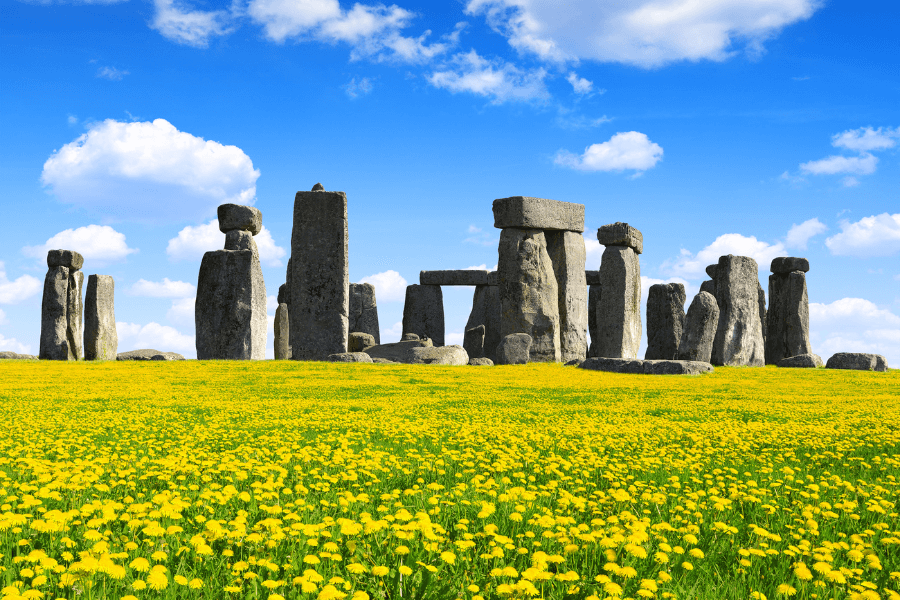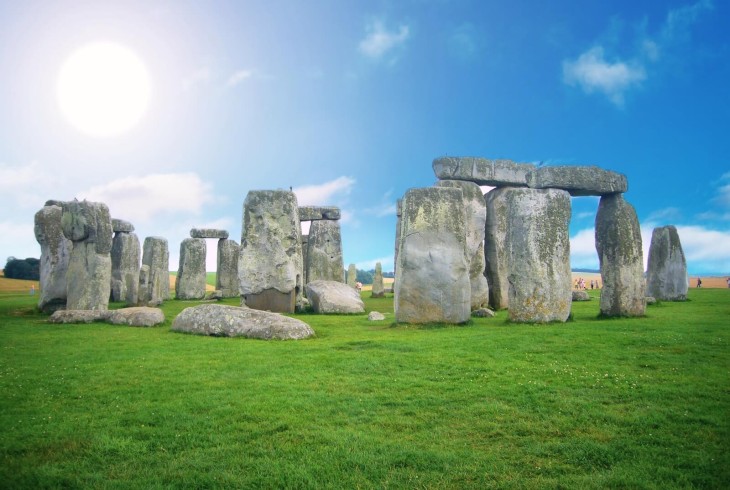Perhaps the world’s most iconic monument to the mysterious world of prehistoric Britain, Neolithic Stonehenge has stood as silent sentinel on the lonely Salisbury Plain for more than 4,000 years. An awe-inspiring testament to the ingenuity of our distant ancestors and remarkable feat of prehistoric engineering, much about this enigmatic circle of massive stones remains shrouded in mystery - making it a source of enduring fascination for the more than a million visitors who flock to the Wiltshire countryside each year (Stonehenge is an easy day trip from London) in the hopes of uncovering its beguiling secrets.
This week on our blog we’re delving into Stonehenge's rich history, looking at the site’s historical significance, the debates surrounding its purpose, how it was built, and, perhaps most importantly, how you can visit Stonehenge for yourself!
Prehistoric Origins: A Quick History of Stonehenge

Stonehenge's history dates back over 4,000 years, to the late Neolithic and early Bronze Age - making it one of the world's oldest man-made structures. The monument's construction took place in several phases, and Stonhenge only gradually took on the form that we recognise today over the course of numerous building campaigns that spanned many centuries.
The earliest phase of construction began around 3100 BCE: this was when the circular earthwork enclosure known as the “Henge” itself was created. Stonehenge’s builders dug a deep ditch, probably using excavating tools crafted from animal antlers, and built up an outer bank surrounding it using the dug-out chalk soil. The bank circumscribed an inner area of around 100 metres in diameter. Inside the ditch, a ring of 56 wooden posts provided a central focus to the site.
The second major phase of development at Stonehenge occurred a few hundred years later, with the arrival of the first stones around 2400-2200 BC. These were the so-called bluestones - comparatively modest granite rocks (at least compared to what was to come) weighing between 2 and 4 tonnes each, which were lugged all the way from the Preseli hills in Wales - over 150 miles from Stonehenge - and organised into a circular pattern within the space of the Henge, creating a smaller inner ring.

Stonehenge’s builders obviously liked the effect of the new stone circle, as it wasn’t long afterwards (around a century later) that they repeated the act, creating a new outer stone circle. Only this time, the stones were on an altogether different scale. The massive Sarsen stones are Stonehenge’s most recognisable feature, 13 feet tall, seven feet wide and tipping the scales at a meaty 25 tonnes each. They were transported from the Marlborough Downs around 20 miles away, and placed into the horseshoe arrangement that we still see today. A large standing stone, known as the “heel stone” was placed at the entrance to the site at an unknown date.
The final major phase of construction occurred around 2,400 BC, when large, flat stones were placed atop the Sarsen standing stones to act as lintels, creating the distinctive arches known as trilithons that we see today. The lintels were carefully shaped and carved to fit and balance on the uprights, using sophisticated mortise and tenon joints that showcase the extraordinary engineering skills the prehistoric builders possessed.
What was the purpose of Stonehenge?
 The stones at Stonehenge are not simply arranged at random. In fact, the main axis of the stones is aligned with remarkable precision to the solstitial axis. This means that on the midsummer solstice the sun rises over the Heel Stone, and at midwinter it sets in the small gap between the two tallest trilithons. The carefully thought out placement of the stones demonstrates that the ancient site had great symbolic or religious significance for the people responsible for its construction. But what was it?
The stones at Stonehenge are not simply arranged at random. In fact, the main axis of the stones is aligned with remarkable precision to the solstitial axis. This means that on the midsummer solstice the sun rises over the Heel Stone, and at midwinter it sets in the small gap between the two tallest trilithons. The carefully thought out placement of the stones demonstrates that the ancient site had great symbolic or religious significance for the people responsible for its construction. But what was it?
Medieval writers built up various fantastic myths to explain the mysterious structure, and the 12th-century writer Geoffrey of Monmouth asserted that it was built by giants in Ireland before being magically transported across the sea by the wizard Merlin to provide a suitable burial place for the heroes of Arthurian legend. Later authors mistakenly took Stonehenge to be some kind of Druidic shrine. The flaw in that theory? Druids were high-status priests in Celtic societies, and the Celts only made it to Britain thousands of years after Stonehenge was constructed.
These days scholars and archaeologists are unified in the conviction that at its most basic level Stonehenge served as an ancient prehistoric temple, carefully aligned with the movements of the sun and moon. But whilst theories abound as to exactly what went on here, the precise purpose of the monument continues to elude definitive explanation.

Hypotheses include Stonehenge having origins as a burial ground - caches of human bones and evidence of cremation from as far back as 3000 BC have been found on the site - or a memorial site commemorating ancestral figures. Others believe that Stonhenge functioned as a kind of Neolithic astronomical observatory - a kind of massive celestial calendar that helped track the movements of the sun and moon as well as the passage of the seasons for agricultural purposes.
The careful celestial alignment of the stones may also indicate that Stonhenge was designed to serve as a spiritually potent site for religious ceremonies and celebrations. Paths leading through the site could have been used for processions on the summer and winter solstices, when the site’s symbolically resonant architecture came into its own.
In truth, it seems likely that Stonehenge served all of these purposes and probably more, although the exact circumstances of its purposes and significance will never be known.
How was Stonhenge built?

Another enduring mystery of Stonehenge is just how its neolithic creators managed to transport the large bluestones and gigantic Sarsen stones across the country to the site.
Current evidence indicates that the more-than 80 bluestones were quarried in the Welsh hills and transported to the Salisbury Plain via human means (the theory that glacial action had brought the stones to southern England has yet to find corroborating evidence), either overland or by sea.
The sarsen stones, meanwhile, are made from a kind of sandstone that is found in great abundance across the topography of southern England, and archaeologists think that the great stones used at Stonehenge came from the Marlborough Downs 20 miles to the north.
Theories about how the two kinds of stones were transported and erected vary, but it likely involved a combination of rolling on greased logs and sledges (the wheel was still unknown in Britain at the time), techniques that were adopted for the long-range transport of heavy loads across the prehistoric world, as well as possibly being floated along waterways.
How to visit Stonehenge

In 1986, Stonehenge was designated a UNESCO World Heritage Site - one of the first places in England to make it onto the list - recognizing its global cultural significance. Over the years, conservation efforts have focused on stabilising and protecting the stones, controlling erosion, and providing additional context for visitors to the site. In 2013 a new visitor centre was opened, providing an immersive experience that includes interactive exhibits, archaeological artefacts, and a shuttle service to the monument, minimising the impact of foot traffic.
Visiting Stonehenge requires some planning. Tickets should be booked in advance, as visitor numbers are limited to protect the site and can sell out quickly in the summer months. The site is usually open between 9am and 8pm during the summer, from 9:30am to 7pm in April, May and September, and 9:30am to 5pm in the winter months. For up-to-date opening hours and to book your tickets, check the English Heritage website.
On-site tours are available and can enhance your understanding of the monument's history and significance. Through Eternity Tours also offer guided itineraries that visit Stonehenge alongside the magnificent nearby town of Bath on our most popular day trip from London. Check out all the details here!



